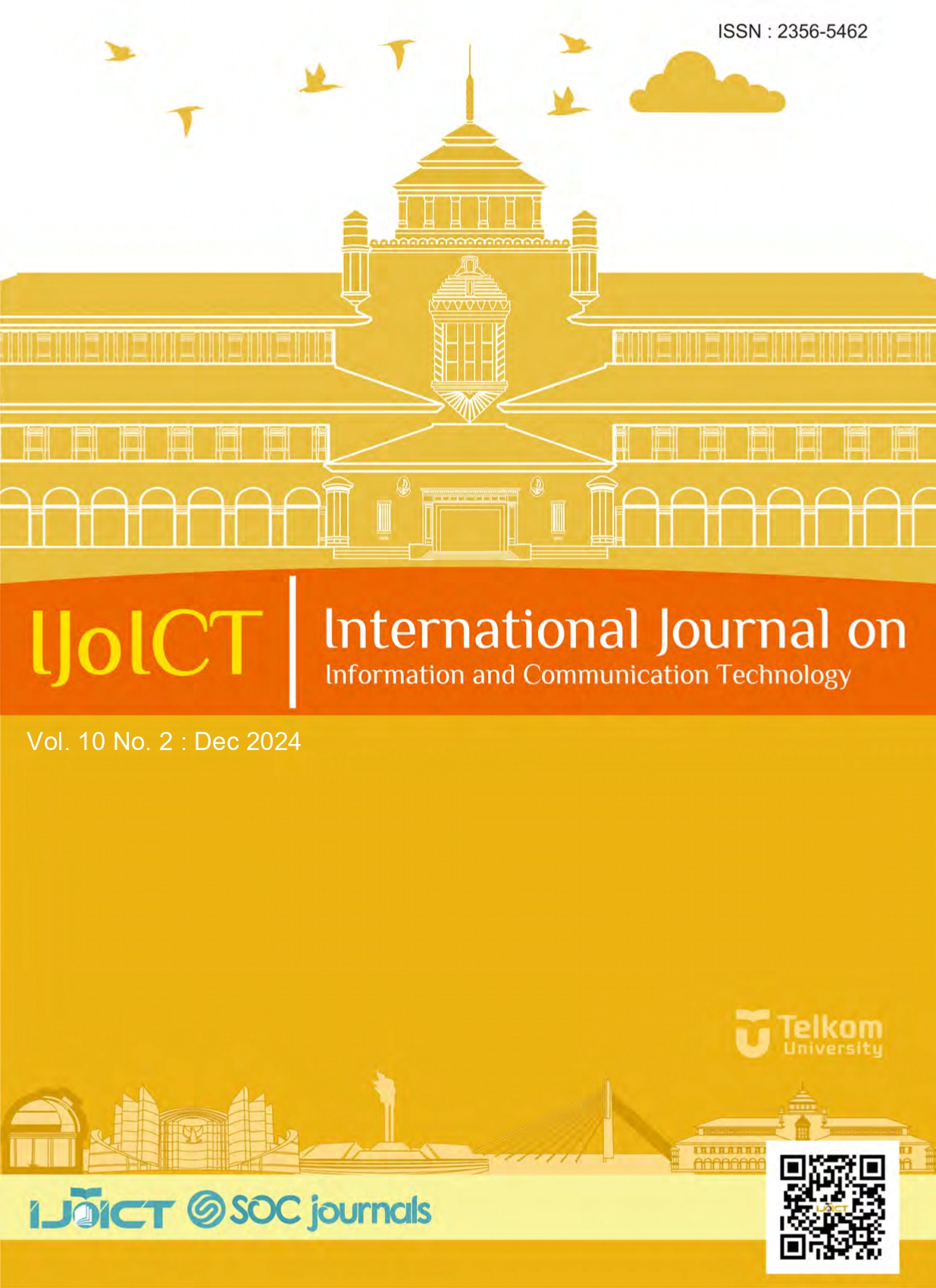Prediction of Classification of Air Quality Distribution in Java Island using ANN with Time-Based Feature Expansion and Spatial Analysis
DOI:
https://doi.org/10.21108/ijoict.v10i2.1035Keywords:
Air quality, Artificial Neural Network, Prediction, Time-based feature expansion, Spatial analysis, Java IslandAbstract
Air pollution is a major concern that significantly impacts human health and the environment, especially in densely populated and economically active areas like Java, Indonesia. Air pollution is primarily caused by motor vehicles and industrial activities, leading to higher concentrations of harmful pollutants such as carbon monoxide (CO), nitrogen oxides (NOx), and particulate matter (PM10). In this study, an Artificial Neural Network (ANN) model is employed to forecast air quality classifications across Java Island, utilizing time-based features and spatial analysis. The model achieves an impressive accuracy and an F1-score of 92.19%, demonstrating its capability in capturing the intricate dynamics of air quality. These results highlight the potential of the ANN model in supporting effective policy-making, crisis management, and the development of environmentally sustainable infrastructure.
Downloads
References
[1] S. Aswatha et al., “Smart air pollution monitoring system,” Global Nest Journal, vol. 25, no. 3, pp. 125–129, Mar. 2023, doi: 10.30955/gnj.004396.
[2] M. A. Fath, “Literature Review : Pengaruh Kualitas Udara dan Kondisi Iklim Terhadap Perekonomian Masyarakat Literature Review : The Influence Of Air Quality and Climate Conditions on The Community Economy,” 2021.
[3] K. Kumar and B. P. Pande, “Air pollution prediction with machine learning: a case study of Indian cities,” International Journal of Environmental Science and Technology, vol. 20, no. 5, pp. 5333–5348, May 2023, doi: 10.1007/s13762-022-04241-5.
[4] S. ’Mulyono, “KLHK Sebut Risiko Pencemaran Udara di Jawa Tinggi, Tidak Hanya di Jakarta,” JawaPos.com. Accessed: Aug. 11, 2024. [Online]. Available: https://www.jawapos.com/nasional/012704898/klhk-sebut-risiko-pencemaran-udara-di-jawa-tinggi-tidak-hanya-di-jakarta
[5] N. Kusminingrum, G. Gunawan, P. Litbang, J. Dan, and J. A. H. Jl, “POLUSI UDARA AKI BAT AKTI VI TAS KENDARAAN BERMOTOR DI JALAN PERKOTAAN PULAU JAWA DAN BALI,” 2008.
[6] B. Berkala et al., “Biosaintifika 5 (1) (2013) The Role of Plants Against Air Pollution in The Protocol Street of Semarang City,” 2013. [Online]. Available: http://journal.unnes.ac.id/nju/index.php/biosaintifika
[7] A. Singh Bharatpur, “A LITERATURE REVIEW ON TIME SERIES FORECASTING METHODS,” 2022.
[8] H. Liu, G. Yan, Z. Duan, and C. Chen, “Intelligent modeling strategies for forecasting air quality time series: A review,” Apr. 01, 2021, Elsevier Ltd. doi: 10.1016/j.asoc.2020.106957.
[9] R. Qamar and B. Zardari Ali, “Artificial Neural Networks - An overview,” 2023. doi: 10.58496/mjcsc/2023/015.
[10] J. T. Hardinata, M. Zarlis, E. B. Nababan, D. Hartama, and R. W. Sembiring, “Modification of Learning Rate with Lvq Model Improvement in Learning Backpropagation,” in Journal of Physics: Conference Series, Institute of Physics Publishing, Dec. 2017. doi: 10.1088/1742-6596/930/1/012025.
[11] M. Robnik-ˇ, “Explanation of Prediction Models with ExplainPrediction,” 2018. [Online]. Available: https://fri.uni-lj.si/en/employees/marko-robnik-sikonja
[12] B. Nikparvar and J. C. Thill, “Machine learning of spatial data,” Sep. 01, 2021, MDPI. doi: 10.3390/ijgi10090600.
[13] K. L. Du, C. S. Leung, W. H. Mow, and M. N. S. Swamy, “Perceptron: Learning, Generalization, Model Selection, Fault Tolerance, and Role in the Deep Learning Era,” Dec. 01, 2022, MDPI. doi: 10.3390/math10244730.
[14] Y. S. Park and S. Lek, “Artificial Neural Networks: Multilayer Perceptron for Ecological Modeling,” in Developments in Environmental Modelling, vol. 28, Elsevier B.V., 2016, pp. 123–140. doi: 10.1016/B978-0-444-63623-2.00007-4.
[15] S. S. Prasetiyowati, A. Yahya, and A. A. Rochmawati, “Performance of Time-Based Feature Expansion in Developing ANN Classification Prediction Models on Time Series Data,” Intl. Journal on ICT, vol. 9, no. 2, pp. 162–176, 2023, doi: 10.21108/ijoict.v9i2.868.
[16] Rima Dias Ramadhani, A. Nur Aziz Thohari, C. Kartiko, A. Junaidi, T. Ginanjar Laksana, and N. Alim Setya Nugraha, “Optimasi Akurasi Metode Convolutional Neural Network untuk Identifikasi Jenis Sampah,” Jurnal RESTI (Rekayasa Sistem dan Teknologi Informasi), vol. 5, no. 2, pp. 312–318, Apr. 2021, doi: 10.29207/resti.v5i2.2754.
[17] M. Zare, H. R. Pourghasemi, M. Vafakhah, and B. Pradhan, “Landslide susceptibility mapping at Vaz Watershed (Iran) using an artificial neural network model: A comparison between multilayer perceptron (MLP) and radial basic function (RBF) algorithms,” Arabian Journal of Geosciences, vol. 6, no. 8, pp. 2873–2888, Aug. 2013, doi: 10.1007/s12517-012-0610-x.
[18] H. Putra and N. Ulfa Walmi, “Penerapan Prediksi Produksi Padi Menggunakan Artificial Neural Network Algoritma Backpropagation,” Jurnal Nasional Teknologi dan Sistem Informasi, vol. 6, no. 2, pp. 100–107, Sep. 2020, doi: 10.25077/teknosi.v6i2.2020.100-107.
[19] M. Rijal et al., “Perbandingan Kinerja Metode Seleksi Fitur untuk Mendeteksi Aktivitas Trojan Performance Comparison of Feature Selection Methods for Detecting Trojan Activity.”
[20] S. Keputusan Dirjen Penguatan Riset dan Pengembangan Ristek Dikti, N. Chamidah, M. Mega Santoni, N. Matondang, F. Ilmu Komputer, and U. Pembangunan Nasional Veteran Jakarta, “Pengaruh Oversampling pada Klasifikasi Hipertensi dengan Algoritma Naïve Bayes, Decision Tree, dan Artificial Neural Network (ANN),” Jurnal Resti, vol. 1, no. 3, pp. 635–641, 2017.
[21] B. K. Hidayatullah, M. Kallista, C. Setianingsih, P. S1, and T. Komputer, “PREDIKSI INDEKS STANDAR PENCEMAR UDARA MENGGUNAKAN METODE LONG SHORT-TERM MEMORY BERBASIS WEB (STUDI KASUS PADA KOTA JAKARTA) PREDICTION OF AIR POLLUTANT STANDARD INDEX USING THE WEB-BASED LONG SHORT-TERM MEMORY METHOD (CASE STUDY IN THE JAKARTA CAPITAL SPECIAL REGION).” [Online]. Available: https://data.jakarta.go.id/
[22] M. A. Fauzi, R. F. N. Firmansyah, and T. Afirianto, “Improving sentiment analysis of short informal Indonesian product reviews using synonym based feature expansion,” Telkomnika (Telecommunication Computing Electronics and Control), vol. 16, no. 3, pp. 1345–1350, Jun. 2018, doi: 10.12928/TELKOMNIKA.v16i3.7751.
[23] T. Desyani, A. Saifudin, and Y. Yulianti, “Feature Selection Based on Naive Bayes for Caesarean Section Prediction,” in IOP Conference Series: Materials Science and Engineering, IOP Publishing Ltd, Aug. 2020. doi: 10.1088/1757-899X/879/1/012091.
[24] H. Purnomo and R. A. E. Wijaya, “Pemetaan Sebaran Kadar Al2O3 dan RSiO2 Pada Endapan Laterit Bauksit Menggunakan Pendekatan Metode Interpolasi Ordinary Kriging Dan Inverse Distance Weighting,” Angkasa: Jurnal Ilmiah Bidang Teknologi, vol. 14, no. 1, May 2022, doi: 10.28989/angkasa.v14i1.1227.
[25] E. Respatti et al., “Perbandingan Metode Ordinary Kriging dan Inverse Distance Weighted untuk Estimasi Elevasi Pada Data Topografi (Studi Kasus: Topografi Wilayah FMIPA Universitas Mulawarman) Comparison of Ordinary Kriging and Inverse Distance Weighted Methods for Estimation of Elevations Using Topographic Data (Case Study: FMIPA University of Mulawarman’s Topographic),” Jurnal EKSPONENSIAL, vol. 5, no. 2, 2014.
[26] A. H. Suhendar, A. A. Rohmawati, and S. S. Prasetyowati, “Performance of CART Time-Based Feature Expansion in Dengue Classification Index Rate,” Sinkron Jurnal dan Penelitian Teknik Informatika, vol. 9, no. 1, pp. 1–9, Jan. 2024, doi: 10.33395/sinkron.v9i1.13023.
[27] F. Rozi, F. Sukmana, J. Pendidikan Teknologi Informasi, and S. PGRI Tulungagung Jl Mayor Sujadi Timur no, “PENGGUNAAN MOVING AVERAGE DENGAN METODE HYBRID ARTIFICIAL NEURAL NETWORK DAN FUZZY INFERENCE SYSTEM UNTUK PREDIKSI CUACA.”
Downloads
Published
How to Cite
Issue
Section
License

This work is licensed under a Creative Commons Attribution 4.0 International License.
Manuscript submitted to IJoICT has to be an original work of the author(s), contains no element of plagiarism, and has never been published or is not being considered for publication in other journals. Author(s) shall agree to assign all copyright of published article to IJoICT. Requests related to future re-use and re-publication of major or substantial parts of the article must be consulted with the editors of IJoICT.








.png)

.jpg)




